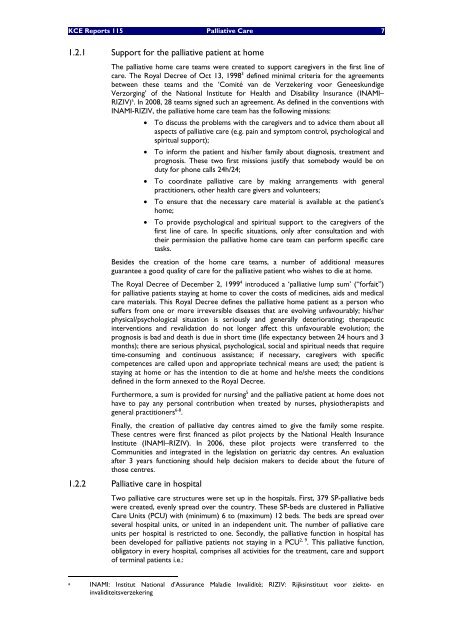Organisation des soins palliatifs en Belgique - KCE
Organisation des soins palliatifs en Belgique - KCE
Organisation des soins palliatifs en Belgique - KCE
You also want an ePaper? Increase the reach of your titles
YUMPU automatically turns print PDFs into web optimized ePapers that Google loves.
<strong>KCE</strong> Reports 115 Palliative Care 7<br />
1.2.1 Support for the palliative pati<strong>en</strong>t at home<br />
The palliative home care teams were created to support caregivers in the first line of<br />
care. The Royal Decree of Oct 13, 1998 3 defined minimal criteria for the agreem<strong>en</strong>ts<br />
betwe<strong>en</strong> these teams and the ‘Comité van de Verzekering voor G<strong>en</strong>eeskundige<br />
Verzorging’ of the National Institute for Health and Disability Insurance (INAMI–<br />
RIZIV) a . In 2008, 28 teams signed such an agreem<strong>en</strong>t. As defined in the conv<strong>en</strong>tions with<br />
INAMI-RIZIV, the palliative home care team has the following missions:<br />
• To discuss the problems with the caregivers and to advice them about all<br />
aspects of palliative care (e.g. pain and symptom control, psychological and<br />
spiritual support);<br />
• To inform the pati<strong>en</strong>t and his/her family about diagnosis, treatm<strong>en</strong>t and<br />
prognosis. These two first missions justify that somebody would be on<br />
duty for phone calls 24h/24;<br />
• To coordinate palliative care by making arrangem<strong>en</strong>ts with g<strong>en</strong>eral<br />
practitioners, other health care givers and volunteers;<br />
• To <strong>en</strong>sure that the necessary care material is available at the pati<strong>en</strong>t’s<br />
home;<br />
• To provide psychological and spiritual support to the caregivers of the<br />
first line of care. In specific situations, only after consultation and with<br />
their permission the palliative home care team can perform specific care<br />
tasks.<br />
Besi<strong>des</strong> the creation of the home care teams, a number of additional measures<br />
guarantee a good quality of care for the palliative pati<strong>en</strong>t who wishes to die at home.<br />
The Royal Decree of December 2, 1999 4 introduced a ‘palliative lump sum’ (“forfait”)<br />
for palliative pati<strong>en</strong>ts staying at home to cover the costs of medicines, aids and medical<br />
care materials. This Royal Decree defines the palliative home pati<strong>en</strong>t as a person who<br />
suffers from one or more irreversible diseases that are evolving unfavourably; his/her<br />
physical/psychological situation is seriously and g<strong>en</strong>erally deteriorating; therapeutic<br />
interv<strong>en</strong>tions and revalidation do not longer affect this unfavourable evolution; the<br />
prognosis is bad and death is due in short time (life expectancy betwe<strong>en</strong> 24 hours and 3<br />
months); there are serious physical, psychological, social and spiritual needs that require<br />
time-consuming and continuous assistance; if necessary, caregivers with specific<br />
compet<strong>en</strong>ces are called upon and appropriate technical means are used; the pati<strong>en</strong>t is<br />
staying at home or has the int<strong>en</strong>tion to die at home and he/she meets the conditions<br />
defined in the form annexed to the Royal Decree.<br />
Furthermore, a sum is provided for nursing 5 and the palliative pati<strong>en</strong>t at home does not<br />
have to pay any personal contribution wh<strong>en</strong> treated by nurses, physiotherapists and<br />
g<strong>en</strong>eral practitioners 6-8 .<br />
Finally, the creation of palliative day c<strong>en</strong>tres aimed to give the family some respite.<br />
These c<strong>en</strong>tres were first financed as pilot projects by the National Health Insurance<br />
Institute (INAMI–RIZIV). In 2006, these pilot projects were transferred to the<br />
Communities and integrated in the legislation on geriatric day c<strong>en</strong>tres. An evaluation<br />
after 3 years functioning should help decision makers to decide about the future of<br />
those c<strong>en</strong>tres.<br />
1.2.2 Palliative care in hospital<br />
Two palliative care structures were set up in the hospitals. First, 379 SP-palliative beds<br />
were created, ev<strong>en</strong>ly spread over the country. These SP-beds are clustered in Palliative<br />
Care Units (PCU) with (minimum) 6 to (maximum) 12 beds. The beds are spread over<br />
several hospital units, or united in an indep<strong>en</strong>d<strong>en</strong>t unit. The number of palliative care<br />
units per hospital is restricted to one. Secondly, the palliative function in hospital has<br />
be<strong>en</strong> developed for palliative pati<strong>en</strong>ts not staying in a PCU 2, 9 . This palliative function,<br />
obligatory in every hospital, comprises all activities for the treatm<strong>en</strong>t, care and support<br />
of terminal pati<strong>en</strong>ts i.e.:<br />
a INAMI: Institut National d’Assurance Maladie Invalidité; RIZIV: Rijksinstituut voor ziekte- <strong>en</strong><br />
invaliditeitsverzekering

















